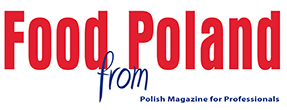The dynamics of export is slowing down. 5.5% y/y might be an excellent result, but until recently, it used to exceed 10%. Other signs of slowdown are visible as well, both in Poland and worldwide, mainly in Europe, which is of vital importance to us. After the crisis of 2008-2010, the world of food processing and trade has been making provisions against the cycles. This process has created, among other things, great logistic, purchasing and sales conglomerates with turnovers higher than the state budget of Poland. I mean such systems as Horizon, featuring Metro, Cassino and Auchan, or EMD, with several dozen commercial companies from many countries. Colossal trade chains and networks come into being and the concentration process becomes vertical, drawing producers, IT, logistics – if only for private label programmes. Transaction values, volumes and assortments are swelling, becoming available in many channels of sales and communication. This is a challenge for the traditional exports/imports model but also a great opportunity to enter a new, superefficient model based on the cooperation of participants and transferring the competition into new economic and non-economic dimensions. This gives rise to a mechanism that will withstand the upcoming slowdown, not just through reduced price levels and market diversification but through enormous amounts of money invested in the value and safety of globally provided products.
A question arises whether the Polish food sector is able to stand out in the emerging reality of a global market; in other words, to transcend/supplement the business model born of simple advantages and a strong modernization push connected with the accession to the EU – to exploit the previous success. One must not remain in a regional niche, even with the best products. This is an essential issue, given the concentration processes in economy and deconcentration ones in politics (see Brexit, the idea of Carolingian Europe, or our visions of the Intermarium). We are good at what we do, but as a dual market, reconciling fragmentation with consolidated segments, we will not achieve much without new, cooperation-oriented strategies of competition and development. Today, we hold a 1.7% share in global food exports. This is much for the CEE region, even for Europe as a whole, but it might not suffice without changes in trade models. Let us be honest – entry into Asia or the USA, on scales available to our companies, is and will be vestigial from the viewpoint of the interests of those markets. Trade balance numbers are merciless. This is a key economic problem, not to mention geopolitical effects. This is not about abandoning Europe or the region and the hitherto area of economic operation but about acquiring broader, non-peripheral prospects for development – including Europe as well.
In spite of any incidents, quality reconciled with a relatively low price remains our strategic advantage and source of success. This is derived, firstly, from our rich culinary culture and wise utilization of new technologies, as well as relatively low costs of labour, service, domestic raw materials. We should not forget our exports come from a market featuring 80% of domestic food. Most of the export supply is comprised, of course, by large companies, about two thirds of which represent foreign or mixed capital, but… On the home market, medium-sized and small domestic companies maintain their position – making up about 40% of the market. Their technological level is comparably as high as their use of European funds and other forms of public support. In connection with the intense inflow of foreign capital into larger ones, a significant potential was created, the utilization of which is not necessarily effective. Regardless of competitive clashes and concentration processes – this is potential for the future, that must not be wasted.
Large companies with foreign capital also participate to a certain extent in the aforementioned process of concentration of the global food market. They enter great purchasing operations with brands of their main shareholders, and with Polish ones (liquor, confectionery, specific cured meats) as well. They also are – the mainstream of Polish presence there – private label suppliers to retail and wholesale distributors. This is a powerful “cost” leverage for Polish food exports. Only through chains active in Poland, it is getting close to PLN 10 billion, and foreign companies place orders in Poland too. This is a process that requires humility but turns out to be very profitable, placing our domestic market on ordering lists of global recipients – the larger, the better; and the greater number of countries, even better. However, a question arises on how to increase the share of other companies, of predominantly domestic capital, in this process. They are doing quite well in the region, in the UK, Germany and Italy, but there is still a very long road from there to operations on a global market. Where is this road, then?
Looking at approx. EUR 75-80 billion) worth of the retail food market, the result of foreign trade seems impressive, challenging the opinion on the internal market being “flooded” with foreign products
The incoming slowdown will obviously accelerate the concentration processes – in Poland too. And it will probably involve large producers acquiring a part of smaller companies, especially those with more interesting products, but… Trade will also reach for production potentials pushed by key players off the market, to earmark their products for private labels by supplying them financially or to make their specific brands into private ones. And this may be the road to a specific structure, connected by its specific nature to great volumes, the road to great markets – dependent but worth the efforts. Soon, an avalanche of good, diverse goods may come into being in the form of private labels of commercial companies whose central offices are present in large purchasing and production/purchasing groups. Of course, our internal market is very absorptive but not enough to prevent arising surpluses; moreover, politicians’ ideas concerning private labels tend not to be very sensible, so exports may turn out to be the mechanism maintaining a position on the Polish market. Therefore, it is in the interest of business and the state to encourage and to support both domestic and foreign business in cooperation with the emerging mega-groups – the trade ones and the cooperative ones. This is the main route of access to non-European markets, since the organization of short-term business missions and anniversary-flagged events or trade fair stands surely is not one.
So the question is, “what to do?” I think the precondition for every action intended to break and develop the existing model of implementation of and support to exports is to acquire knowledge of the mode of operation of cooperatively-organized mega-groups, both those with a flat and with a vertical structure. One should find them, study them, plan a strategy and undertake cooperative negotiations, and then organize to follow it at home. Therefore, the beginning should be decent analytics and consulting – mainly for the government, but not exclusively. One should have knowledge of companies and markets, as well as indicate places and partners to start the negotiations. Then, on the basis of reliable knowledge, one may proceed with reasonable, private-and-public investment in export platforms for manufacturing and commercial companies. Nothing stands in the way of support to smaller companies and encouragement of larger ones to cooperate with a large, internally diverse recipient working on many markets. Guarantees are needed too. To start with, for instance, what just screams to be used is a strategy referencing production resources for items certified as „organic” (bio, eco, natural, etc.) and sparking the interest of potential recipients on global markets. The potential to transform them, giving them appropriate features and functionalities is already there. Thus, one can try to overcome the embarrassing trade balances with China and other non-European countries.
Andrzej Maria Faliński
Expert












